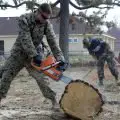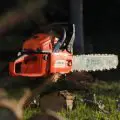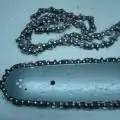People tend to believe that chainsaws are only used to chop would to burn as a source of heat during the winter, but in recent years chainsaws have become more and more popular to use in various maintenance activities around the house and yard.
Regardless of the reason you may need to own a chainsaw, it’s important to understand how exactly does a chainsaw work? In this article, we’ll take a look at each part of the chainsaw and how they work!
Table of Contents
- What Is a Chainsaw?
- Chainsaw Parts & How They Work
- How Do Chainsaws Work?
- FAQs (Frequently Asked Questions)
What Is a Chainsaw?
Before being able to understand how something works, it is crucial to understand what exactly you have got in your hands! A chainsaw is a portable saw that is capable of cutting through wood or wooden objects by the use of its “teeth” running in a circular motion around a guiding bar.
The “teeth” on the blade of a chainsaw is a metal chain that has notches or grooves at certain intervals so that it is able to cut through even the hardest types of wood with relative ease. Your chainsaw horsepower rating and chainsaw engine speed are responsible for the speed at which the blade can maneuver in a circle around the guide bar.
A good chainsaw will be able to help you complete a wide variety of tasks, from landscaping trees and foliage to cutting life-saving firebreaks in heavily wooded areas to even performing art like ice sculpting during the winter! It is always important to practice extreme caution when handling a chainsaw ensuring you use it safely for all types of tasks.
Visit our how to use a chainsaw safely guide for more information!
You can also purchase particular PPE (personal protective equipment) such as pants and jackets that are lined both externally and internally with the thinly interwoven wire that is made specifically to be worn during chainsaw operation.
These pieces of clothing are designed to stop a blade from harming you by blocking it with the wire; which can prevent a fatal accident.
Chainsaw Parts & How They Work
A chainsaw is quite a complex tool that consists of both major and minor parts that all play a vital role in cutting through wood smoothly. Note, that without a vital part being connected or maintained properly; your chainsaw will not work to the best of its abilities and could potentially damage the wood you are trying to cut or cause an injury to yourself.
Now, we’ll take a look at the following parts of a chainsaw and how they work:
- Engine
- Carburetor
- Drive mechanism
- Chain brake
- Cutting chain
Engine
The first and of course most important part of a chainsaw is the engine itself. Without the engine, a chainsaw would actually be more comparable to a hand-held saw that requires intense physical labor for you to be able to cut through the material.
We can differentiate chainsaws into two types via their engines: those that run via a gasoline-powered motor with an oil pump and ignition and those electric chainsaws. The engine is where the chainsaw draws power to run the blade and chain in a circular rotation to cut through the wood.
So, how well do electric chainsaws work? Electric chainsaws are available as either corded or battery-powered. The former need to be plugged into a power outlet at all times in order to work, while the latter is newer to the market, but not as widely used due to its lower power.
This style of chainsaw runs with the use of a lithium-ion battery, similar to those used in a cordless drill. These batteries do not last so long and will require frequent charging, while also not possessing the power those with gasoline/oil or corded-electric engines do.
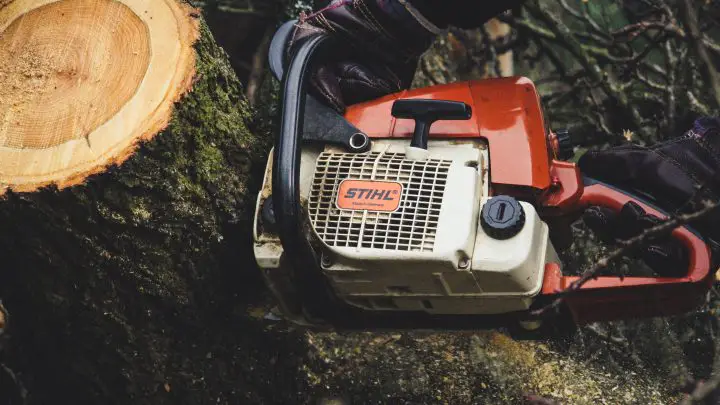
Carburetor
The carburetor channels the air fuel mixture through the gas powered chainsaw to propel the blade and chain assembly into its desired circular motion, allowing it to cut through the wood or material of choice.
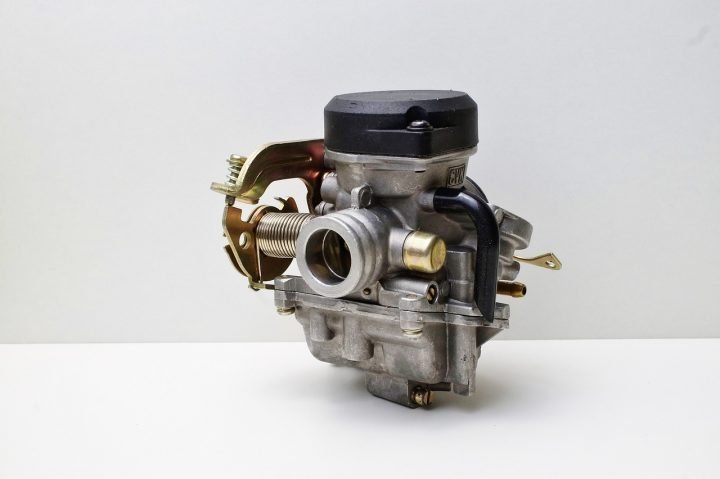
Drive Mechanism
The drive mechanism is where you will find the clutch of the chainsaw located. The clutch is the component that can protect the engine while it is idling still or when the chainsaw experiences a chainsaw kickback.
If a chainsaw is experiencing kickbacks with every use, you must ensure that the chain and blade are still sharp enough to cut through materials. The operator is additionally protected with the clutch engaged as it signals the chainsaw to stop in case of a kickback.
Chain Brake
The chain brake is a miniature brake located in the same area as the clutch. Chain brakes are typically available as automatic, semi-automatic, and manual. The automatic mini-brake will take signals from the centrifugal clutch when the chainsaw experiences a kickback and cease operation of the chain and blade to protect you from any possible injuries.
Cutting Chain
The chainsaw will come equipped with a cutting chain that wraps around the blade of the saw to allow you to cut through the wood. This is the part of the chainsaw that will literally run in a circular motion along the chainsaw guide bar when the chainsaw is connected to its power source, whether that is an electric chainsaw or gas chainsaw, and then cut through the wood.
If you wish to learn about the different chainsaw chain sizes, visit our guide!
It is extremely important to remember that a dull chainsaw chain will not be able to cut through the wood so well or other materials but instead, the operator will experience kickbacks from the chain being forced to essentially “jump” off the material.
The chain is the first of all the components that will require replacement after a certain period of use. This will typically depend on the material you’re cutting through and the frequency of use.

How Do Chainsaws Work?
How exactly does a chainsaw work is through the use of all these aforementioned parts being powered in tandem to create enough friction to allow the chainsaw to slice through a material with ease. Depending on the type of chainsaw, the engine is powered by either a gasoline/oil mixture or an electrical cord connected to a power outlet.
Air is then pulled through the carburetor to flow through the chainsaw, which powers the chainsaw’s guide bar and chain to spin in its circular motion. This motion will create enough friction on the material to slice through it with ease.
A chainsaw can be started by the use of a starter button or a pull cord, depending on the model, with safety shutoff valves often located along the handle for your ease and convenience.
You should always remember to completely shut off the chainsaw when it is not in use. This is important because the chain will run at a high speed even when there is no material to cut through.
It’s also always important to remember proper safety when using a chainsaw. Ensure everything is sharpened and well oiled, and you’re wearing correct PPE. It’s also vital to keep on top of chainsaw maintenance, conducting it regularly.
FAQs (Frequently Asked Questions)
How does a chainsaw chain cut?
Chainsaw chains operate by being propelled around a guide bar, removing material from the kerf by cutting chips from the side and bottom of the material. Chainsaw chains rather remove material than cut through it. In order to operate properly, the depth to which each tooth cuts must be limited to avoid it binding in the wood and causing issues.
Do chainsaws cut through bone?
Yes, chainsaws are very powerful tools and they will easily be able to cut through flesh and bone. If you accidentally cut yourself with a chainsaw, or witness an accident, it’s crucial to seek medical help immediately.
Can a chainsaw without a chain hurt you?
Yes, of course. But, it’s not recommended to run a chainsaw without a chain. The engine will rev up higher, and this will increase the likelihood of wear and tear. It can also run hot when the throttle is used. You must ensure that you empty the bar oil tank, otherwise oil can spray out of the chainsaw.

